

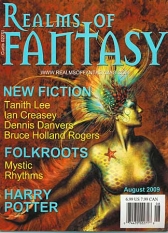


Realms of Fantasy
2009–The Year in Review
by
Steve Fahnestalk
As a book reader, I prefer fiction that doesn’t have a genre emblazoned on the cover (in the case of paperbacks) and, even though I follow a number of series, I generally prefer original series that aren’t based on movies or games. As a magazine reader, I tend to stick with the magazines I know, as money is limited; and in short fiction, a known quantity is usually tastier than “mystery meat.” So the fiction magazines I’ve read recently have been ones like F&SF, Analog, EQMM, and so on. If I thought about Realms of Fantasy at all, it was to assume it had probably sunk under the rising tide of generic gaming fiction, vampire fiction (mostly bodice-ripping) and media rip-offs and succumbed years ago as had Science Fiction Age. So I went the “safe route”—and was pleasantly surprised when I got this opportunity.
I read RoF a few years ago, but stopped reading it for various reasons. Then I got the opportunity to revisit it with this “2009 RoF in Review”—and wondered why I’d ever stopped. Fiction editor Shawna McCarthy has a very sharp eye indeed for a publishable story, and if 2009 is any indicator, I’ve missed some fine fiction indeed.
First, a word about RoF and its format. Since it debuted, back in 1994, the magazine has been a slick, glossy publication (like Science Fiction Age, which died an early death about ten years ago) which publishes not only short stories, but also reviews of fiction, movies and gaming, a gallery of fantasy art and—a happy surprise for me—a column which reminds me somewhat of Avram Davidson’s “Adventures in Unhistory” column that used to appear in F&SF, called “Folkroots.”
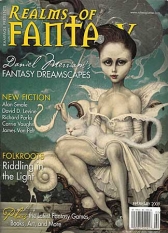 February 2009
February 2009
“The Radio Magician” by James Van Pelt
“The Happiest Place” by Carrie Vaughn
“Joy Is the Serious Business of Heaven” by David D. Levine
“The River of Three Crossings” by Richard Parks
“Fossil Fuels” by Alan Smale
Beginning with the February issue, the five stories here are of uniformly high quality—although they are anything but uniform. I can’t decide which of the five is my favorite; both “The Radio Magician” by James Van Pelt and “Fossil Fuels” by Alan Smales are top-notch stories and would grace any Best of the Year anthology.
The first story is “The Radio Magician” by James Van Pelt, which is set in the early- to mid-‘40s and concerns one Clarence, boy listener, who loves the radio mysteries, the adventure and cowboy shows, but who knows such adventures are not for him, as polio has taken the use of his legs away from him—and who fears the iron lung will be his next stage. (Readers of the modern age will not know how prevalent was the fear of polio, and how the Salk vaccine took those fears away from us in the 1950s, but for many children and adults, polio was an ever-present threat.) So Clarence’s favorite show was Professor Gilded’s Glorious Magical Extravaganza, which was local to the Denver area, and which had inspired Clarence to learn several pieces of coin magic, using the golden half-eagle his mother had given him.
Although this is a period piece, the most recent story it reminds me of is Ellison’s “Jeffty is Five”—which has the same sort of period feel to it. This appears to be extremely well researched, as it set off none of my finely-tuned “BS” monitors… and that always adds to the verisimilitude and effectiveness of a period piece. But like the Ellison story this has at its core the power of belief, and we all know (or think) that there is no belief as pure and sincere as the pre-adolescent child’s.
So Clarence’s faith in Professor Gilded’s magic, and magic in general, leads to a climax that looks like it’s going to be cliché; but here Van Pelt has a surprise in store, and proves himself a better author than some. While a lesser writer would magically cure Clarence’s polio, Van Pelt eschews the easy out, and thereby gives the reader a stronger, more affective story (and effective as well) in the end.
“The Happiest Place” by Carrie Vaughn is another “sick kids” story—she works as a “Sleeping Beauty”-type princess at a Disneyland clone—but her job involves a lot of “Make-A-Wish Foundation” kids. Here the ending is more predictable than Van Pelt’s, but still effective.
“Joy Is the Serious Business of Heaven” by David D. Levine pictures Heaven as a bureacracy—which most of us who have worked in government or big business would vehemently disagree with—but in this case, the story works all right. The humor is sometimes a bit forced; and perhaps this would be stronger if it weren’t the third of three stories in a row where things promise to come out okay for the most vulnerable character, if not the lead character.
“The River of Three Crossings” by Richard Parks is apparently part of a Japanese series he’s writing, though I can’t recall reading anything by him before. It’s set in the Heian period (approx. 800-1200) when Kyoto (then called Heian-kyo) was the capital of Japan. It’s a well-written piece about trying to lay a ghost to rest. If you’re at all familiar with Japanese ghost stories (and if you’ve seen The Grudge, you are at least a little), their ghosts are not just hanging around saying “boo”—Japanese ghosts are often vengeful and can kill the living, so exorcism is both risky and necessary. A nice read, and very authentic-feeling.
“Fossil Fuels” by Alan Smale is the cream of this particular crop and the longest story in the issue. Here, Jung’s collective archetypes have been embodied in human form generation after generation. We humans are myth-makers and have probably been since we were aware beings, and perhaps we needed our myths to make us stronger and more able to face the dangers of an unknowable universe, but maybe the myths we’re consciously creating now are making the ancient ones unnecessary.
In the Yorkshire coal mines of the late ‘30s, a “wrong-un’” has made himself at home, and it’s up to Rosalind, a “Cunning Woman,” to go down the mine and set things right. Only neither person is what he or she appears to be, and they are about to dance a dance as old as humanity—and I’m not talking about the horizontal bop. The world is changing, and is about to become much stranger than anyone from previous times could have ever foreseen. And Jack, who has had many names (like “Jack in the Green” and “Robin Goodfellow”), just wants to talk to Rosalind about what’s happening. He says.
Rosalind’s guide is a young man named Peter and, like another Peter in a different time, is set to deny her three times before their trip down to that black, dusty hell is through. Peter wants to know what kind of Cunning Woman Rosalind is, and she tells him she can see both ways—that is, she remembers the future as well as the past—though she assures him they will both come out of the mine after she defeats her enemy.
Without giving too much of the plot away, I will just say that the characters portrayed here make the story kind of far-reaching and gut-wrenching. Instead of being about one person with life-threatening issues, like the first three stories, this one is about humankind’s major issues and a major shift in how we perceive and deal with change. And maybe even archetypes can change if the future can.
Altogether, a good issue, though not without copyediting problems—in the first story, the protagonist is called “Charlie” on the first page, though his name is Clarence throughout the rest of the story; also, the last story uses that horrible neologism “alright” instead of the proper “all right”… but these flaws don’t really weaken the issue badly.
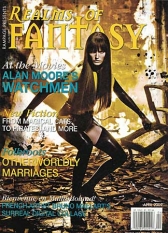 April 2009
April 2009
“Impractical Cats” by K.D. Wentworth
“Sails Above Greensea” by Adam Corbin Fusco
“Name Day” by Garth Upshaw
“Sand Castles” by Desirina Boskovich
“Impractical Cats” by K.D. Wentworth deals with a couple named Thomas and Clarey, who’ve been married almost seventy-two years. If you do the math, assuming the story takes place today, they were married just about when T.S. Eliot published his Old Possum’s Book of Practical Cats, from which this story derives its title. But Thomas and Clarey are not cat people; indeed, they buried their last dog, a dachshund named Pepper, almost three years ago. So why should Clarey suddenly insist they had cats?
This is a lyrical story about the end of life; but containing ample warnings about the dangers that lurk in wait for us all as our days dwindle down to a precious few. One of those dangers is senile dementia (now called Alzheimer’s); another is brain damage caused by minor strokes, or TIAs (Transient Ischemic Attacks). Clarey has had at least one TIA already, which had taken weeks to heal and caused her to forget the names of some common things—and Thomas is afraid that the personality of Clarey is going to leave him before her body does.
But Clarey’s cats are no ordinary cats—they can bring home not dead rodents, but stars and bits of wind. And Clarey says they’ve always had cats, but she just couldn’t see them until now, and soon Thomas would see them too. A nice little tale, which put me in mind of Spielberg’s “Kick The Can” from John Landis’s Twilight Zone movie.
“Sails Above Greensea” by Adam Corbin Fusco made me want to say “Arr” for quite a while after reading it. It’s pyrates (sic)! Up in the air!
Monteroy Absinthe is captain of the Crimson Moon (one of the two surviving Greatships on a world that has been largely swallowed by Leviathan)—a winged ship with more than a hundred decks that plies the air currents from Cumulo up to Cordelio. But Cap’n Absinthe has a problem—he’s the unluckiest pyrate that ever sailed; his own father, who betrayed his own crew and civilians, and captains the Dauntless, is trying to beat him to the Crown of the First And Last Pyrate King.
Fusco has built a world of Ocean, inhabited mostly by the inhabitants of these two giant airborne vessels, and a culture like our 17th- and 18th-century pirates did. Their world has three moons and contains a purple gas called “argent dyoro,” which enables the big ships to fly. It’s a conflict between Captain Absinthe and his father, Abelairde, who has made a pact with “what lurks in the deep,” not only over who will wear the Crown, but whether appeasement is the tack to take to keep Leviathan from swallowing what land remains.
As I did, you will probably envision the Kraken from Pirates of the Caribbean, and possibly even Captain Jack Sparrow—and maybe this story owes something to those films; but in the end, this is a pretty original take on the whole pirate thing. I mean “pyrate,” of course.
However, the author (and the editor) need to learn the difference between the homophones “might” and “mite”—which took me out of the story a couple of times. And why “argent” (which means silver) when the gas is purple? Despite those errors, a fun story.
“Name Day” by Garth Upshaw is as original a science fiction story as I’ve read for quite a while. I can’t think of another like it. Our young protagonist is almost 13, and lives on an island in the middle of an intelligent ocean. Rather than water, this ocean contains “a vast network of intelligences”—which is kept at bay by a series of some sort of “guardian orbs” that ring the island, set on concrete pillars, but whose influence is waning year by year.
The island’s inhabitants (who are the sole inhabitants of the planet, now) have a tradition that on Name Day, a child’s 13th birthday, each child is dipped in the “ocean”—and becomes transmogrified. One child becomes a firestarter, another grows gills—and some mutate beyond saving and die. The CEO names each child after their transformations are complete.
But teenagers are rebellious—and some become addicted to “imbibing”—and thereby hangs a very different tale indeed. As I said, unique, original, and well written.
“Sand Castles” by Desirina Boskovich rounds out the April issue. Nat is a recent graduate of Art School, who’s living with his dad in Pensacola for the summer while he figures out what he’s going to do for a living. He receives a call from his art-school buddy Radley, who says he’s flying into Pensacola and needs a place to crash.
When Radley arrives, he’s accompanied by Audra, a wispy blonde with “too many earrings”—but who somehow captivates Nat; and the two talk our protagonist into taking a drive along the coast to find a beach. But not just any beach—they’re looking for a specific beach with pink quartz sand, that can grant wishes. So they drive all around the Gulf of Mexico from Pensacola to Mexico itself, to find this one specific beach.
As an ex-Florida resident myself, I thought this was kind of weird—Florida (southeast of Pensacola) has some killer beaches, and it’s totally counterintuitive to drive hundreds of miles west and south to Mexico, but they find what they’re looking for. And while they find resolution for their stories, the author leaves it unresolved for the reader, which creates a welcome tension for this story which was, to be frank, somewhat lacking in it. Although well written, the story doesn’t give us what we really need, which is a reason to care about the protagonists and what happens to them. I thought that story-wise (but not the writing), this was the weakest of the four.
August 2009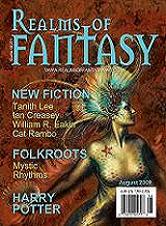
“Our Lady of Scarlet” by Tanith Lee
“Healing Benjamin” by Dennis Danvers
“Digging for Paradise” by Ian Creasey
“Well and Truly Broken” by Bruce Holland Rogers
The August issue begins with “Our Lady of Scarlet” by Tanith Lee. A story of the Plague Years, set in some unnamed European city in the 14th century, apparently—though neither year nor city is here named. The story is good, though fairly minor—the titular Lady is a demon who’s using the fear of the plague, and the belief that the color red will protect from the plague, to gather adherents.
The protagonist, Andelm, is a scholar who doesn’t believe in God, but believes he is curious enough, and aloof enough from the world, not to catch the plague. He also has a certain facility with protective magic that he feels will help keep him safe in an emergency. Well written, as all Tanith Lee stories, but not “best-of” material.
“Healing Benjamin” by Dennis Danvers is about Jeffrey and his cat, Benjamin. When Jeffrey was 16 and Benjamin was dying at 17 (extreme old age for a cat), Jeffrey got “the healing touch” and brought Benjamin back from the dead—and at the time the story takes place, Jeffrey is 46 and Benjamin is still a year older, which makes him about 329 in cat years. Although the story is steeped in pathos by the end, there’s some funny business in the middle, which I’ll try not to spoil for you, although the story’s illustration gives it away.
Jeffrey finds that Benjamin’s curious longevity and health, which have to be concealed (as must the fact that Benjamin can actually speak) from any love-interests tends to somewhat curtail his social life. But he perseveres and reveals his secret to Shannon, who immediately wants him to apply his talents to her comatose brother. This is probably the first story I can remember reading about a near-immortal talking cat, and I enjoyed it.
“Digging for Paradise” by Ian Creasey concerns one Hadro, digger, who is working for the magician Ren Gessel. It seems Hadro’s wife, Arione has offended the Paragon (their ruler) and has been imprisoned, and in order to afford the bribes necessary to free her, Hadro needs to make a 900-plus-foot dig for Ren Gessel.
When we say “magician” here, we’re speaking of actual magic users—these magicians bury “power stones” which absorb the Earth’s magic over a period of years, and then use them to achieve whatever ends the magicians deem necessary. Only Ren Gessel hasn’t told Hadro everything… they’ve all gone into stasis for an unbelievable amount of time in order to power these particular stones past all previously-known powering. An interesting concept, and well handled.
“Well and Truly Broken” by Bruce Holland Rogers confused me… maybe I’m just too shallow to get it. Rose and her two sisters Lily and Iris have been warned not to play in the forest (this appears to be the same kind of forest that all fairy tales have—like the one in which Hansel and Gretel found the witch’s house, and where the Babes in the Woods were lost), but one day they disobey and meet a strange girl who can dance in the sky to music played by unseen musicians.
She tells them they may be able to join her and her sisters but their “race” is powered by broken hearts, and Rose and her sisters must each break a heart, and that heart must be well and truly broken. They all promise that they will each allow some young man to fall in love with them and then never marry, thus ensuring that his heart is well and truly broken. They then return home to the workaday world, to chores from daylight to darkness. Maybe it’s their hearts which will be broken, but I must say I don’t really follow. A short-short that didn’t work for me.
A good issue, but no outstanding stories.
October 2009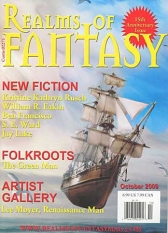
“Flower Fairies” by Kristine Kathryn Rusch
”Tío Gilberto and the Twenty-Seven Ghosts” by Ben Francisco
“Nell and the Devil” by S.E. Ward
“Red Dirt Kingdom” by Jay Lake
“Bob and the Mermaid” by William R. Eakin
So now we turn to October 2009, which begins with:
“Flower Fairies” by Kristine Kathryn Rusch concerns a woman who had never expected to follow the family business, but when she inherited the funeral parlor did so anyway. In her earlier years this woman had found a glade near her home inhabited by flower fairies, who are very powerful and also very terrifying to a young girl. At one point in her young life, she had taken her father to the glade in hopes that he would utilize the fairies to make the bouquets needed for a funeral business, but the fairies had made him forget and had punished her. She still kept in touch as an adult, however, and her Blackberry had Roderick’s number on speed dial (although technology doesn’t work well around fairies, Roderick can use a cell phone, at least once or twice until it dies).
Helena is an older woman, perhaps over 100 years old, whom our protagonist (unnamed) had befriended, but who appeared to have few other friends, so when she died, our heroine had resolved to take the extra bouquets from the well-attended funerals so Helena would have some flowers at her viewing; surprisingly, a young flower fairy shows up with an arrangement in a vase. And at the end of the story, our protagonist has learned something about her friend, the fairies, and herself. Nicely done, like so much of Rusch’s fiction.
(I might, however, be inclined to point out to Michael Hague, who has illustrated this with a Froud-ish fairy with greenish skin, that green is not the color of loam. Surprising, for Hague, who’s a genuinely good illustrator.)
”Tío Gilberto and the Twenty-Seven Ghosts” by Ben Francisco has made me take a long time in finishing this review. Not because it’s a bad story, or badly written—far from it—but the story made me severely conflicted. The story contains some fairly explicit sexual images, and I strongly feel that explicit sex doesn’t belong in major magazine fiction. Unless it’s Playboy or something. And because that sex is gay sex, I needed to be able to explain my objection without appearing homophobic. And my objection would be the same if this were a story of heterosexual explicitness… but because the sexual content is part of the reason for the story, I can’t just dismiss it out of hand.
The story concerns one James, who lives in the Bronx and does stand-up comedy. He finds New York oppressive and so determines to visit his uncle Gilberto in San Francisco. Uncle Gilberto doesn’t go out much, because he’s perfectly happy in a house with twenty-seven ghosts—his show-biz friends like Daniel, and Tomás—they all sit around the piano in feather boas and such and sing show tunes (although James can only hear Tío Gilberto and the piano). When James goes out and gets a social life (and meets Kaspar), uncle Gilberto warns him to be sure to “wear a parachute” when making love.
Well, he does… for a while. Then Kaspar solicits him over and over that they need to be “flesh to flesh” and that the condom just gets in the way—till he gives in, and then guess what? Like the football star who seduces the cheerleader, as soon as he gets what he wanted, Kaspar goes away. (Maybe Kaspar is the twenty-eighth ghost.)
Leaving us and James with a bigger problem than a missing boyfriend. You will guess the ending, which is more of a question than an ending. And when you’ve read this, you’ll see my dilemma too, which is—can this story work at all without some explicitness? I don’t think so, and so I have to say that this story has to stand as is; it’s a story about human relationships, ghosts notwithstanding, and it’s pretty important. I recommend it, if not wholeheartedly, at least unreservedly.
“Nell and the Devil” by S.E. Ward is a totally different take on an old fairytale. I won’t be giving anything away by telling you that the culmination of this story involves a pair of slippers, though in this case they’re not made of glass. And the name Nell is a derivative of Eleanore—much more familiar to us than the diminutive Ella, perhaps. But this 17th- or 18th-century tale involves a young girl of no means at all whose primary task in a certain type of house involves cleaning up the cinders, and whose secondary task involves performing a different type of duty for half a penny a throw.
I am, however, thoroughly confused by the author’s use of the term “haypenny”—as a half-penny is almost universally called a “ha’penny.” Nothing to do with hay at all, it’s a simple abbreviation. The use of haypenny is a problem, as it interferes with the story, which it shouldn’t. Otherwise, this story (I can’t call it a retelling, as it is almost a new invention) is very good and evokes a simpler and more brutal time quite effectively. And Ward leaves us wondering if Robert Sly is, in fact, the Devil. Good story.
“Red Dirt Kingdom” by Jay Lake is a funny story about Artimesia Cleminshaw and the Proverbial Stranger. Artimesia lives in rural Oklahoma (or maybe Texas), in the Red Dirt counties; although she’s a woman of rare discernment (the cars up on cinder blocks in her yard are Fiats and Porsches), she’s not what you’d call attractive—she’d need “a beauty operator and two pounds of stage makeup to look as good as forty miles of bad road.”
But that’s not why Proverbial is there—he’s looking for Artie, who’s the Secret Heir to a kingdom. A real kingdom, and there’s a real problem—the heir has to be male. Which Artie, name notwithstanding, is definitely not. Who she is and how Proverbial solves the problem to the satisfaction of all (you’ll understand that comment when you read it), is the meat of the story. Fun and well written fantasy that doesn’t turn out the way you’d expect.
“Bob and the Mermaid” by William R. Eakin is set in Redgunk, Mississippi—and Bob Delashmit is a devoted husband, whose wife, Dina Marie, appears to be one of those Southern women (like Cool Hand Luke’s mother) who’s permanently abed from one ailment or another. Bob, who’d been a hellion in high school, is a devoted husband who only leaves his wife’s side to go fishing occasionally with Dell (the P.O.V. character).
But Bob finds a mermaid, and in the telling of that story we find the depths to which human emotion and feeling can plumb, and the heights to which they can soar. Although the mermaid only takes one human at a time to be with her, and is “insatiable,” Dell doesn’t believe Bob will go with her, not while Dina Marie is alive (though half-deaf and blind). Another welcome installment in the author’s “Redgunk” series of tales, this story is so good, and so well told, that it is probably a candidate for an anthology.
December 2009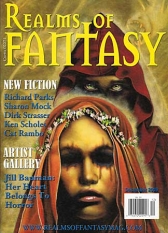
“Stories of the Sand” by Dirk Strasser
“A Road Once Traveled” by Richard Parks
“Felicity’s Engine” by Sharon Mock
“In Time of Despair and Great Darkness” by Ken Scholes
“Narrative of a Beast’s Life” by Cat Rambo
December 2009 is the last volume of the year and the decade, and it starts with:
“Stories of the Sand” by Dirk Strasser, a sort of a classic Arabian Nights sort of story. Shemchur and his daughter, Shemselnar are in a small caravan of sorts traveling across the Red Desert seeking the rymlands, which are the repository of Lost Things.
They are guided by Jaliyya, whose people like to ride their camels naked under the hot sun, and their small group is rounded out by the mysterious traveler Rathekin, who in contrast to Jaliyya, hides every portion of his skin under voluminous hooded robes and wears gloves.
Shemchur is in search of Shemselnar’s lost eyes (and perhaps redemption for his own sins—because it was in punishment for his own sins that Shemselnar lost her eyes), Jayyelna is just the guide and Rathekin is silent on the subject of what he seeks. They are all guided by the hissing sounds of the sands—for when they are close enough to the rymlands, the sands will speak in actual words to the travelers and they may find what they are looking for.
What happens to these four travelers makes a compelling story in the tradition of Scheherezade, and provides a worthy introduction to this last volume of 2009. Well written.
“A Road Once Traveled” by Richard Parks is another type of fairy tale set in, it appears, England, although the voice is much more contemporary than the usual “once upon a time” story. When John Sinterhill reaches the age of 56, he decides to seek his fortune and so sets out on the road; in his travels he meets a troll guarding a bridge, a talking magical fox, and finds a different kind of fortune than he had ever expected. It’s a slight tale, but well thought out; as a man of somewhat mature years myself, I was glad to see a protagonist who wasn’t a twenty-something idiot. (You can imagine how frustrating a lot of recent movies are for “people of a certain age” who aren’t entirely stupid.) I liked it and I think you will too.
“Felicity’s Engine” by Sharon Mock has no human protagonist at all; in some ways it is set in a “once upon a time” milieu, but in other ways not. Cat and Dog live alone in a ruined city—once home to fairies, but now ruined by the humans and their machines of war. They guard the body of their mistress who, as both reader and Cat realize, has passed on—but the Dog, Felicity, doesn’t care, as he is her guardian until he dies.
The Cat, however, has found and repaired one of the broken machines (the titular Engine) so that they might use it to aid them in their search for provender in the ruined city. The Dog, however, sees that if they take it to the Fairy Queen, she might bring their mistress back to life in return. What happens with the Fairy Queen, and the rewards of loyalty in the fairy world, form the backbone of the story, and it’s definitely in keeping with what we know (and think) of how fairies behave. Recommended.
“In Time of Despair and Great Darkness” by Ken Scholes is an odd take on the Arthurian legend; you’ll recognize that legend almost from the start, so why the author is so coy about revealing it is beyond me (and besides, the illustration gives it away). The key point here is that the protagonist, although named “Artie,” is definitely not the reincarnation of King Arthur, although he shares some of Arthur’s characteristics.
Another war is approaching, and the Oklahoma farm on which Artie and his parents live a hardscrabble life is worthless, except to the men of the so-called “Merlin Trust”—because they know that a certain artifact is buried on the farm. Artie’s Uncle Mordecai brought home an old sword he found buried in Ypres during the Great War; a sword that was beaten into a plowshare when Artie’s uncle Got Religion—and the first time he tried to use that plowshare, it got stuck in a buried outbreak of granite, and has remained there ever since.
A well-told little story that brings a new twist to an old story. I enjoyed it.
“Narrative of a Beast’s Life” by Cat Rambo has, like the Mock story, a non-human protagonist. Only this protagonist, called Fino by his fellow centaurs (and Philip by his human masters) is a slave. The setting is vaguely Greek around the time (I’m guessing) of the Peloponnesian Wars (or even earlier); only this is the Greece of myth and legend.
There are many Beasts, and most of them that live near humans are slaves—taken against their wills and sold in marketplaces for whatever uses their human masters (and mistresses) have for them. Intelligent (most can speak, from oracular pigs up to our protagonist’s kin, the centaurs), but denied even basic human rights, the Beasts are oppressed.
Set in the form of a nineteenth-century novel, with subtitles and such, this story details the struggles of Fino and his fellow Beasts to be free—they do not believe in Human Gods, even when the Humans insist that the Gods have given them domain over all the Beasts. (Sound familiar?) Although it does not end on a particularly happy note, it is rather uplifting, and makes one question (not for the first time) the ethics of those people who seem to believe that God, or Gods, have given them sway over everything that exists. A pointed commentary indeed, and well couched in fantasy terms. A fitting coda for RoF’s decade, I think.
So that’s my 2009 review—if I appear to have given some stories short shrift, it’s only because I was asked to hit the highlights, and since there’s not a bad story in the entire bunch (just one confusing one, the Rogers—and that could be me, missing the point)—every story is well written—I needed to say something about all of them.
[Editor’s note: Following the above 2009 Overview by Steve Fahnestalk, we present a second complete review of the December 2009 issue by Nader Elhefnawy.]
“Stories of the Sand” by Dirk Strasser
“A Road Once Traveled” by Richard Parks
“Felicity’s Engine” by Sharon Mock
“In Time of Despair and Great Darkness” by Ken Scholes
“Narrative of a Beast’s Life” by Cat Rambo
Reviewed by Nader Elhefnawy
The first story in the December 2009 issue of Realms of Fantasy is Dirk Strasser‘s “Stories of the Sand,” the narrator, a man of the Sakhr people named Semchur; his daughter Shemselnar; and the mysterious pilgrim Rathekin; all travel with a guide named Jaliyya to the rymlands, prowled by memory-stealing creatures named nemrils. Semchur’s hope is that in the rymlands he will find a way to restore his daughter’s eyes–taken from her by their sages as punishment for Semchur killing a man who sexually assaulted her in the course of trying to defend her. Strasser succeeds in tying his various threads together, and achieves an appropriately dream-like effect in the relation of the story.
In the next story, “A Road Once Traveled,” Richard Parks plays the game of turning genre tropes on their heads, in this instance the fairy tale in which a young man heads out into a world of trolls, giants, princesses, enchantments and all the rest to find his fortune. (His hero John Sinterhill is instead an aging widower thinking about retirement.)
To Parks’ credit, he eschews the lazy and rarely rewarding paths of obvious (often mean-spirited) parody and anachronistic pop cultural references too often taken (especially in television and film), instead crafting a clever and charming variant on a familiar theme.
During my first reading of it, Sharon Mock‘s “Felicity’s Engine,” in which a cat and dog in a ruined Fairy City encounter a “sapper engine” like the machine used in an earlier, devastating attack, promised something similar. While certainly having the intrinsic charm a reader might expect, Mock’s story suffers somewhat from its vagueness on a number of key plot points (inside its mere two-page length).
Ken Scholes‘ “In Time of Despair and Great Darkness” is the story of Arthur Lee Bach, an Oklahoma farm boy during the Dust Bowl whose world is turned upside down when mysterious visitors with an odd interest in the sword his uncle picked up during World War I (and tried to turn into a ploughshare) buy up the family’s property. What follows is pretty standard stuff, despite a few confusing bits (not the least of them, the blue turbans the villains are wearing), but Scholes’s voice and pacing carry the tale.
(Incidentally, it has been noted that the formatting of the magazine–specifically, the absence of the end-sign–at the story’s conclusion makes the text appear incomplete. However, RoF nonfiction editor and art director Douglas Cohen has confirmed on his blog that the text in the issue is fully intact.)
The concluding piece, Cat Rambo‘s “Narrative of a Beast’s Life” (currently available as a podcast from PodCastle) is the slave narrative of Fino, a centaur in a world where magical, mythical and supernatural beings from dragons to djinn are victims of a massive system of religiously sanctioned chattel slavery.
Rambo combines the fantasy trappings with a grim realism she maintains to the end. Indeed, it might be argued that with only minor alterations “Narrative” could be a piece of straightforward fictionalized history. However, one thing can be said for this approach–specifically that putting a different face on a familiar event (like that of the African slave trade) can make readers look at it in a new way–and on the whole Rambo’s execution of the idea is effective and polished.
***
[Editor’s note: We thank RoF editor Doug Cohen for his kindness in supplying the April issue, thereby making this Realms of Fantasy 2009 Overview complete.]